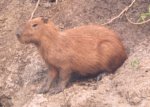 The capybara (Hydrochaeris hydrochaeris) is a semi-aquatic herbivorous animal and lives in South America, east of the Andes. It is the world's largest living rodent. Adults reach 105 and 135 cm (40-55 in) in length, and weigh as much as 35 to 65 kg (75-140 lbs). They are good swimmers, and have partially webbed feet. They do a lot of things in the water: mating, hiding from predators, and they can stay submerged for several minutes. Capybaras can even sleep underwater, by leaving their noses just above the water to breathe.
The capybara (Hydrochaeris hydrochaeris) is a semi-aquatic herbivorous animal and lives in South America, east of the Andes. It is the world's largest living rodent. Adults reach 105 and 135 cm (40-55 in) in length, and weigh as much as 35 to 65 kg (75-140 lbs). They are good swimmers, and have partially webbed feet. They do a lot of things in the water: mating, hiding from predators, and they can stay submerged for several minutes. Capybaras can even sleep underwater, by leaving their noses just above the water to breathe.
Which zoos have them?
Artis (Netherlands), Saint Louis Zoological Park (United States) and Smithsonian National Zoological Park (United States)The Capybara is listed as Least Concern (LR/lc), lowest risk. Does not qualify for a more at risk category. Widespread and abundant taxa are included in this category, on the IUCN Red List of Threatened Species
Countries
Argentina, Brazil, Colombia, French Guiana, Guyana, Panama, Paraguay, Peru, Uruguay and VenezuelaSome facts about the
Capybara
Adult weight : 55 kg (121 lbs)
Maximum longevity : 15 years
Female maturity :456 days
Male maturity : 456 days
Gestation : 150 days
Weaning : 103 days
Litter size : 5
Litters per year : 1
Interval between litters : 245 days
Weight at birth : 1.5 kg (3.3 lbs)
Weight at weaning : 8.299 kg (18.2578 lbs)
Basal metabolic rate : 37 W
Body mass : 26.385 kg (58.047 lbs)
Temperature : 36.85 °C (98.33 °F)

Custom Search